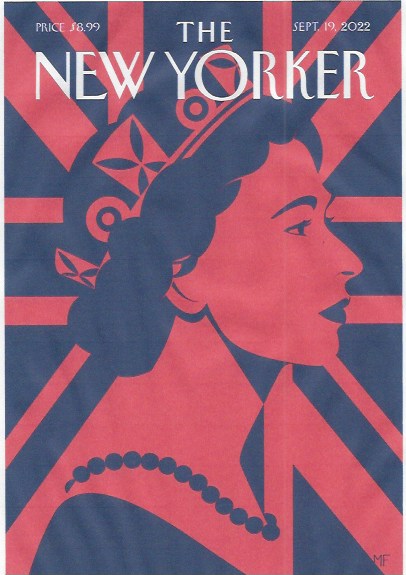Queen Elizabeth II (1926-2022)

Yesterday was a special day in the lives of millions of people throughout the world, and I’m grateful to have been among the lucky ones on “our side of the pond” who were able to get up at 4AM to witness this event.
As it happened, my favorite image of all that we’ve seen since September 8, when Elizabeth II died at her summer retreat at Balmoral Castle in Scotland, came not from the UK but from our own media, from the September 19th issue of The New Yorker. Malika Favre’s beautiful “Figurehead” seems to have struck a chord that we Americans wanted to see as her reign came to an end, after seventy years.
And I gather from all that was said that the planning had gone on for years, and this royal funeral was particularly designed to be unlike any other. We heard that the queen herself had taken part in much of the planning over the years and there was much fine commentary shared during the multi-hour event.
[I watched on the BBC YouTube channel which in almost all respects was beautifully done. Sadly, however (and provoking this rather ungrateful nagging aside from me), whatever technology was used to provide the English-language titles flashed across the bottom of the BBC screen offered almost laughable errors coming in nearly every phrase – remarkably amateurish. Apparently the wording was based on some audio source for the word but I don’t think any of us watching allowed this dissonance to distract us from what was going on.]
The overall impression of the State Funeral was very fine, starting out with the almost perfect late summer weather: a gorgeous sunny day, and perfect for the tens of thousands of people who filled the route of the two processions taking place. The “forming” of some six thousand military marchers in the early morning and the second march was spectacular, the one-and-one-half miles from Westminster Abbey, the site of the funeral, to the Wellington Arch, where the coffin was transferred to a glass-topped hearse for the drive to Windsor Castle for the burial (known as “the commitment”) in the royal vault in St. George’s Chapel, Windsor Castle
We learned much about how it was all done, and we were even told that Her Majesty herself provide a list of her favorite music on her 90th birthday. The music, it seemed to me, was performed beautifully by the men and boys of the abbey choir, all of it bringing back happy memories for me. When I lived in England in the mid- to late-1980s, and being the lover of church music that I am, I was able to take a break from my studies every afternoon at 3pm for Evensong. Of all the many cathedrals where I was able to attend and whose choirs I heard (I was researching English cathedral libraries at the time), Westminster Abbey’s choral evensong service became very special for me, and I’ve never forgotten my time there.
Other memories came back, despite my never having had anything to do with royal activities and being – like many Americans – almost naturally not a Royalist. But you don’t live in London (where I was much of my time, using the British Library for my research) or Canterbury (my primary residence) or travel about to other cathedral cities without having some sense of the royal family, sometimes on a daily basis.
And it did happen that once, in 1986, when I was staying with a friend near Kensington High Street, I heard that I would be there on a special day. Having a few days of research in London that week (and this time including working with the Sub-Librarian at Westminster Abbey) I learned that Prince Andrew and Sarah Ferguson were to be married on July 23. So we all decided to skip work and go early to get in line to see the procession (and the Westminster Abbey Library would be closed anyway). We all crammed together up against the barriers (yes, it was very crowded, but perhaps not to the extent we witnessed yesterday), and we got to watch and cheer as the happy couple were driven in the Glass Coach to their wedding at Westminster Abbey. It was great fun, and whatever we think about all that’s happened with that branch of the royal family, back in 1986 my friends and I enjoyed being there to share in the excitement.
So perhaps that’s what it is all about, the memories and the overall inclusion of royal affairs in people’s lives, even people who are not part of the population of the United Kingdom. I certainly don’t have the sense – among any of my friends and colleagues – that the attention to the royal family is bad or harmful. In fact, for many of us, it provides (despite some lapses) many remarkable things to think about. Do I have a special memory of the many I have about the queen? Of course, and for each of us our memories are different but I’ll never forget how when the hearse with Lady Diana’s body passed by, Queen Elizabeth, standing with Prince Philip, was seen to slightly genuflect, honoring her own daughter-in-law. It was a moment never to be forgotten.
So it’s all about memories, isn’t it? And timelessness. Yes. Timelessness, stability, a sense of being together, all the millions of us. Together with something to pass on the future generations, along with the hope that they, too, will be able to sense the values and beliefs, character, ethics, and standards that mark these hundreds of years of history. It is, indeed, timeless.
Leave a Reply